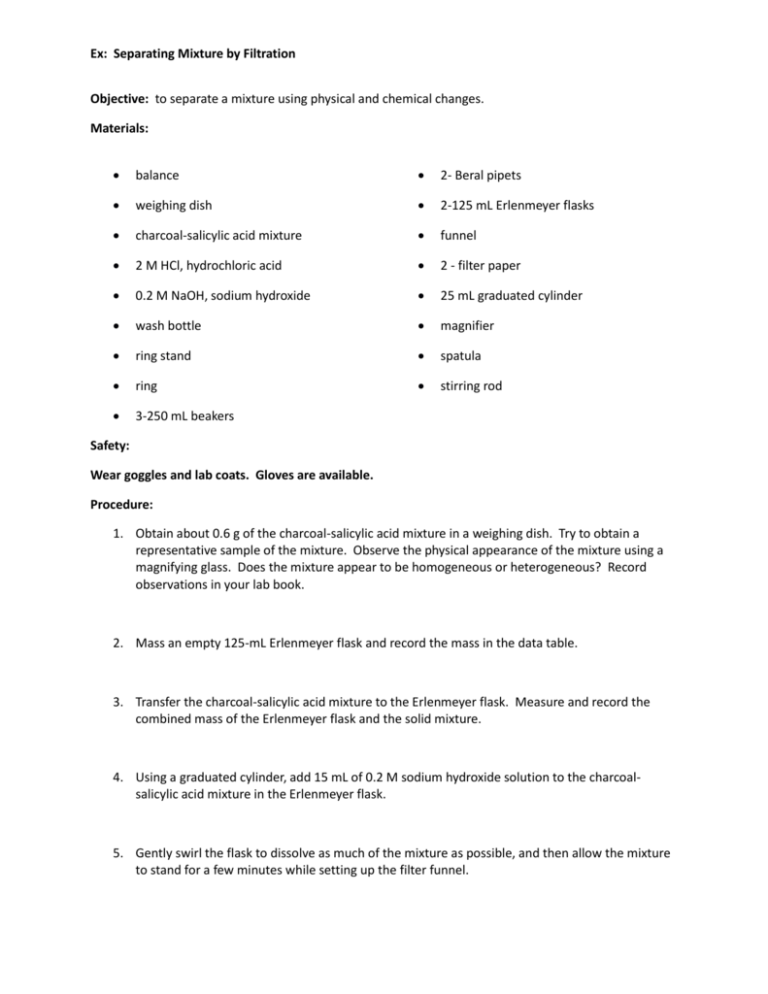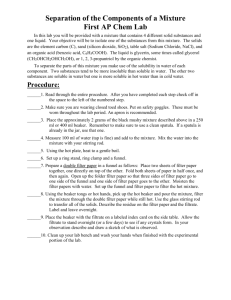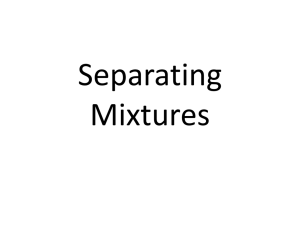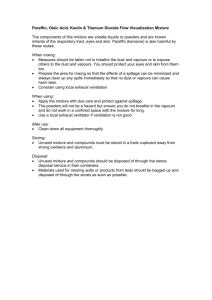Ex: Separating Mixture by Filtration Objective: to separate a mixture
advertisement

Ex: Separating Mixture by Filtration Objective: to separate a mixture using physical and chemical changes. Materials: balance 2- Beral pipets weighing dish 2-125 mL Erlenmeyer flasks charcoal-salicylic acid mixture funnel 2 M HCl, hydrochloric acid 2 - filter paper 0.2 M NaOH, sodium hydroxide 25 mL graduated cylinder wash bottle magnifier ring stand spatula ring stirring rod 3-250 mL beakers Safety: Wear goggles and lab coats. Gloves are available. Procedure: 1. Obtain about 0.6 g of the charcoal-salicylic acid mixture in a weighing dish. Try to obtain a representative sample of the mixture. Observe the physical appearance of the mixture using a magnifying glass. Does the mixture appear to be homogeneous or heterogeneous? Record observations in your lab book. 2. Mass an empty 125-mL Erlenmeyer flask and record the mass in the data table. 3. Transfer the charcoal-salicylic acid mixture to the Erlenmeyer flask. Measure and record the combined mass of the Erlenmeyer flask and the solid mixture. 4. Using a graduated cylinder, add 15 mL of 0.2 M sodium hydroxide solution to the charcoalsalicylic acid mixture in the Erlenmeyer flask. 5. Gently swirl the flask to dissolve as much of the mixture as possible, and then allow the mixture to stand for a few minutes while setting up the filter funnel. Ex: Separating Mixture by Filtration 6. Set up a funnel for filtration as shown in class. Place a clean 125-mL Erlenmeyer flask under the funnel to collect the filtrate. 7. Measure and record the mass of a piece of two pieces of filter paper. Find the average mass and record in your data table. Fold the filter paper into a cone and place it in the funnel. Wet the paper with a few drops of deionized water from a wash bottle. 8. Using a stirring rod to direct the stream of liquid, slowly pour the mixture from the Erlenmeyer flask into the funnel. Note: Gently swirl the flask as you pour to transfer as much of the solid and liquid together as possible. 9. When most of the liquid has passed through the funnel, rinse any remaining charcoal from the Erlenmeyer flask into the funnel with a small amount of additional sodium hydroxide solution. You need to rinse all the solids from the flask into the filter paper. 10. Rinse the solid on the filter paper with a small amount of deionized water. This step rinses the solid in the filter paper. Why is rinsing with deionized water necessary? 11. Label one of 250-mL beaker with your initials of the group members and the lab station number. When the filtration is complete, carefully remove the filter paper with the charcoal from the funnel and place it in the beaker. Place the beaker in the oven so that the filter paper and residue can dry. 12. Using a Beral pipet, add one pipet full of 1 M hydrochloric acid at a time to the filtrate until no more white solid precipitates out. Swirl the flask to mix the contents. Note: Three pipets full of hydrochloric acid, HCl, should be enough. You may test the solution with pH paper to check that it is acidic. Ex: Separating Mixture by Filtration 13. Place the second piece of filter paper the rinsed funnel. 14. Slowly pour the precipitate into the funnel. 15. When most of the liquid has passed through the funnel, rinse any remaining salicylic acid from the Erlenmeyer flask into the funnel with a small amount of deionized water. 16. When the filtration is complete, carefully remove the filter paper with the precipitate, which is salicylic acid, from the funnel and set in another 250 mL beaker labeled with your initials. 17. Place both beakers with residues in the oven and let them dry overnight. 18. The remaining filtrate may be rinsed down the drain. Data Table Mass of 125-mL Erlenmeyer Flask (g) Mass of Erlenmeyer flask and charcoal-salicylic acid mixture (g) Mass of filter paper (g) (Step 7) Mass of filter paper and charcoal (g) (Step 17) Mass of filter paper (g) (Step 13) Mass of filter paper and salicylic acid (g) (Step 17) Analysis Show all work in your lab book. Be sure to include the question or enough information so that you know exactly what the question asked. Show the numbers involved when you subtract one from another. Ex: Separating Mixture by Filtration 1. Why is it necessary to rinse the charcoal in the filter paper with deionized water? 2. Calculate the original mass of the charcoal-salicylic mixture. Show the subtraction in your lab book and box your answer. Be sure to include units with your answer. 3. Calculate the mass of recovered charcoal. 4. Calculate the mass of the recovered salicylic acid. 5. Calculate the total mass of the recovered solids. 6. Calculate the percent recovery of the charcoal-salicylic mixture. 7. In a similar manner, calculate the mass percent of salicylic acid in the mixture. 8. Label each of the following as a physical or a chemical change: a. Salicylic acid is neutralized by the sodium hydroxide solution. b. The mixture is filter to separate the charcoal. c. The filtrate is acidified to precipitate the salicylic acid. 9. Salicylic acid may be crystallized from hot water by dissolving the solid in a minimum amount of boiling water and then cooling the mixture to room temperature. Is this a physical or a chemical change?









